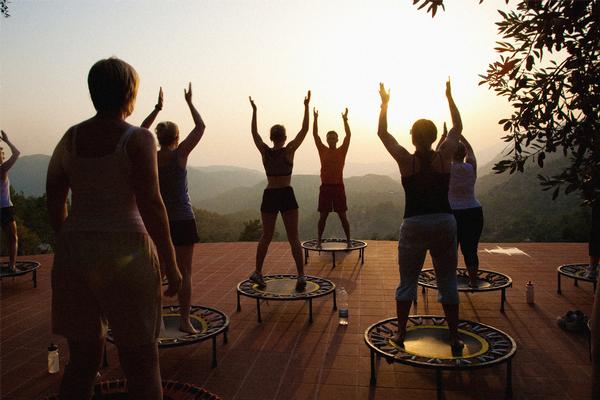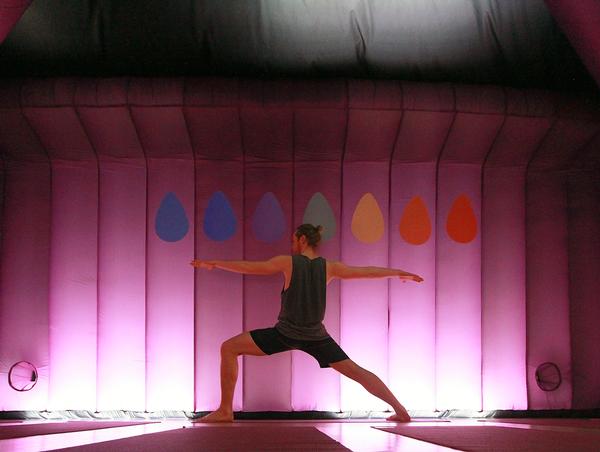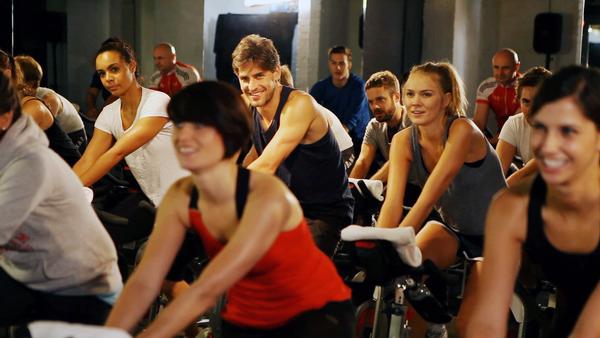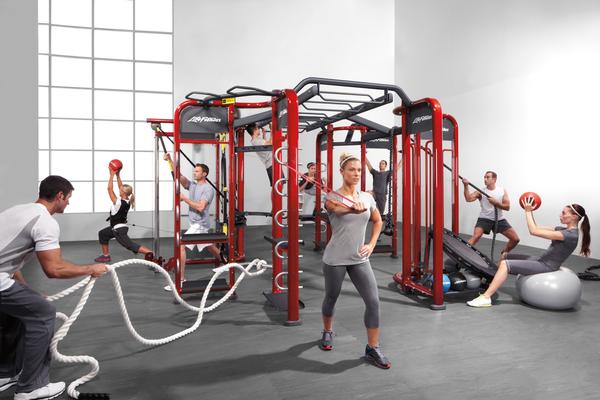
|
Wearable tech

We’re moving from an era when we interfaced with technology using a keyboard and mouse, to a time where touch and voice are the new norm and putting on our wearable technology – watches, glasses, etc – is just routine (see p32).
This will give us voice-activated access to functionality which enables us, for example, to have a display in our field of vision, to film and take pictures with ease, and to search, translate, communicate and share on the go.
Innovations such as Google Glass, Google’s augmented reality glasses, and rival Telepathy One will find business- and consumer-facing applications in the fitness industry. By enabling the capture and sharing of video from a user’s eye view, this new technology will be used by instructors and PTs to share coaching demos in real-time; by health club staff on the gym floor, who will be able to bring up a member’s profile, interests and workout history while speaking to them, maximising the impact of their interactions; and by members, who will be given Google Glass pre-loaded with virtual workout programmes.
The growth in image-based technology is also turning photography and video into communication media that replace words in some contexts – a valuable resource in an increasingly global economy.
| |


|

Google Glass will find business- and consumer-facing applications in fitness |
|

|
Mobile biometrics

Consumers can already monitor all elements of their health – from stress levels to sleep patterns – via biometric readers. This presents health clubs with an exciting opportunity for constant engagement with customers.
We see a time when health clubs offer apps that monitor and analyse all clients’ key health indicators, then give lifestyle advice based on the findings via wearable tech. This advice can be given in real-time so people can make better choices, such as how many more calories can be consumed that day, when they need to be more active or when it’s time to take a break.
This level of engagement with customers will keep health clubs top of mind with tech-savvy customers, ensuring fitness apps and wearable technology complement rather than replace health club membership going forward.
The interactivity, analytics and instant feedback offered by this new breed of technology will also further the fitness sector’s cause with the medical and public health bodies it aspires to partner with. In providing evidence and outcome data, as well as encouragement to individuals to take responsibility for their own health, such apps may prove to be the stepping stone that finally cement the medical and fitness worlds together.
| |


|

Fitness apps and gadgets can complement, not replace, gym membership |
|

|
Rebranding Exercise

Improved customer insight will lead to new approaches in all facets of health club operation, including the way clubs position their offering to members and prospects.
Research conducted in the US by Michelle Segar (michellesegar.com), and published in the International Journal of Behavioral Nutrition and Physical Activity, found members are more likely to stick with exercise routines and maintain membership if they have tangible, immediate reasons for doing so.
Although weight loss remains one of the main reasons people give for joining a gym, this wasn’t found to translate into sustained activity in the same way as other, shorter-term goals. Those who focused on enhanced quality of daily life – lower stress, better sleep, increased vitality and so on – exercised 34 per cent more than those with weight/appearance goals; 25 per cent more than those with ‘current health’ goals such as lowering cholesterol; and 15 per cent more than those with healthy ageing goals.
While the goals studied were specific to the sample of mid-life women, the principles are transferable: there are many reasons to exercise, and those most often quoted won’t necessarily be the ones that translate into sustained activity. Segar believes people are simply ‘socialised’ by the media to think exercise is for weight loss.
The challenge for the fitness industry in 2014 is to ‘rebrand’ exercise. Clubs must investigate what really drives behaviour change among their specific group of members, then use these insights to inform decision-making and marketing, re-educating members to value the goals that lead to sustained participation.
| |


|

Weight loss is often quoted as a reason to
exercise, but may not lead to sustained activity |
|

|
Last impressions

Member retention remains a huge issue for health clubs, with research suggesting the situation across the UK industry has worsened rather than improved (see p64).
Compounding this situation is the fact that, while many clubs pull out all the stops to engage members when they join, new Leisure-net research conducted exclusively for Health Club Management (see p68) suggests the experience of those thousands of people quitting their health club membership leaves much to be desired.
Operators should therefore be concerned about evidence which suggests customers are more likely to remember the last thing that happened in their relationship with a business than the first*.
With this in mind, health clubs need to place a much stronger emphasis on making a great last impression to ensure, when they’re ready, customers are willing to come back for more.
| |


|

Clubs must ensure the experience for departing members is a good one |
|

|
Wellness Tourism

Wellness tourism is booming, with an economic impact of US$1.3trn a year – this according to SRI International’s new report, Global Wellness Tourism Economy. Wellness tourism already accounts for 14 per cent of total global tourism revenues and is forecast to grow on average 9.9 per cent annually over the next five years – nearly twice the rate of global tourism overall – reaching US$678.5bn, or 16 per cent of total tourism revenues, by 2017.
All this offers significant opportunity to health club operators looking to strengthen relationships with existing members and forge links with new customers.
For primary wellness tourists – those who travel specifically to maintain or enhance personal wellbeing, by visiting a destination spa or retreat – it’s easy to slip back to old ways when the stresses of everyday life return. Health clubs could partner with retreats to support returning wellness tourists with fitness and nutrition programmes delivered in-club to help them maintain healthy habits.
Alternatively, clubs could run their own retreats: residential stress management courses, hiking or yoga weekends. SRI found that 84 per cent of wellness trips are domestic, and wellness tourists are also high yield: they spend, on average, 130 per cent more than the average global tourist. These are people who are willing to invest in their health – a market well worth getting involved with.
Health clubs can serve the secondary wellness tourist market too – those who travel for other reasons, but who want to maintain a healthy lifestyle on the road – by making facilities available to travellers; models like payasUgym.com can help exploit this sector.
The opportunities are there for clubs to harness wellness tourism to drive revenue, build communities and attract new markets.
| |


|

Health clubs could offer packages designed to support returning wellness tourists |
|

|
Pop-up Facilities

Investing in health club infrastructure is costly, and bricks and mortar tie an operation to a specific location permanently. We’re seeing early signs that the pop-up trend, which has taken retailing by storm, will make a big impact on the health club market.
The pop-up format allows existing operators to extend their brands and try out locations on a low-cost basis before investing in permanent operations. Alternatively, it offers opportunities to introduce limited-availability activities – Parkour zones, outdoor events, competitions and challenges – that run alongside the gym, complementing the permanent facilities and keeping the offering fresh.
The affordability of pop-ups also allows new businesses to launch based exclusively on this model. Hotpod Yoga, for example, runs yoga classes in inflatable pods in corporate offices – as often as the company wants, at times to suit them, with pods inflated and deflated for each class.
Pop-ups also allow for innovation and playfulness, attracting non gym-goers who are drawn to an edgier offering. Move – the pop-up gym in London, UK – epitomises this, with regular launches of new class formats and locations including rooftops, piazzas and gardens. A buzzing Facebook community drives the agenda, with input sought on how and where people would like to Move.
| |


|

Operators such as Hotpod Yoga have embraced the pop-up trend |
|

|
Online Reviews

Online reviews are already having a huge impact on service businesses such as hotels and restaurants, and the opportunity is there for health clubs to increase business by encouraging and managing reviews.
A study by economists at the University of California, Berkeley, US, found a variance of just half a star rating can determine whether a business thrives or goes bust. In restaurant reviews on Yelp.com, the difference between 3 and 3.5 stars increased the chance – from 13 per cent to 34 per cent – of a business reaching capacity at peak times.
Meanwhile, research by payasUgym.com found that having four or five customer reviews increased a gym’s sales by 60 per cent; more than five reviews increased sales by a further 150 per cent, and if the gym’s average ranking was three or more out of five, sales went up by 25 per cent. Indeed, anonymous online reviews were found to be over three times more effective than the gym’s own website in influencing prospects, and this increased in line with gym fees – the more expensive the gym, the more effective were online recommendations. Women were particularly open to online feedback.
Dealing well with complaints relating to online reviews was also important: 49.5 per cent of people said they would still buy as long as there were more positive comments than negative, and 30.5 per cent would buy as long as negative comments had been responded to by the gym.
However, too many health clubs currently leave online complaints unaddressed. This must be rectified in 2014.
| |


|

Having four or five online reviews increases gyms’ sales by 60 per cent |
|

|
Specialist Services

The sector will continue to specialise, with microgyms coming to the fore in 2014. This will be led by cycling studios, but with other formats also gaining in popularity, from functional training studios to standalone HIIT (high-intensity interval training) offerings and group exercise-only clubs.
This represents a challenge and an opportunity for traditional clubs. Research by Dr Paul Bedford has highlighted how seasoned gym-goers become more targeted with each new club they join: they want a particular type of yoga, group cycling class or equipment. These are the people who will also consider dropping their traditional gym membership in favour of bells-and-whistles delivery of the activity they specifically want to participate in.
With this in mind, it won’t only be the independent microgyms that occupy this specialist space – full-service operators will also find a way to move into microgym territory. In the UK, David Lloyd Leisure has already secured exclusive rights to the US’ Orangetheory Fitness concept, which it’s rolling out in its high street PT studios. Fitness First has been trialling a number of new models, including – in Sydney, Australia – The Zone, a group exercise-only club. Equinox is rumoured to be eyeing a UK launch for its SoulCycle studio brand. And LAX, the new premium brand from LA Leisure in the UK, is already suggesting its signature short-format classes may be rolled out into smaller footprint, standalone HIIT/functional clubs. Expect to see much more of this in 2014.
| |


|

Microgyms will come to the fore in 2014, led by specialist cycling studios |
|

|
Home Delivery

Fresh prepared food deliveries – meals delivered to order and ready to eat – are a growing industry, as busy consumers choose to control their nutritional and calorie intake by passing responsibility for this on to the experts.
Health clubs have the opportunity to move into this market on a joint venture basis, by lending their name and nutritional expertise to create branded ranges of home-delivered healthy food.
This would enable busy consumers to enjoy nutritionally balanced, fresh food at home as part of their weight management, weight reduction or wellness management programmes.
Apart from the profits that could accrue from this type of deal, health clubs would also gain valuable brand profile from being part of people’s everyday lives. The consumer connection could also be used to market health club memberships, with tailored promotions targeting those buying the healthy ready meals.
| |


|

Busy consumers are increasingly passing responsibility for their nutrition to the experts |
|

|
In-club Technology

Technology has already made great inroads into improving the efficiency, cost-effectiveness and customer experience at clubs around the world, from cashless payments via RFID wristbands to fingerprint/biometric access and exercise tracking built into CV equipment. But two technologies will really come to the fore in 2014.
Virtual classes look set to hit the mainstream. Clubs and even group exercise instructors will increasingly see these as an opportunity, not a threat – driving off-peak usage of studios, getting new people into group exercise via taster sessions, adding an extra dimension to live classes, and even allowing instructors to learn from the world-leading presenters running the virtual classes.
Meanwhile, with energy bills continuing to rise, more clubs will turn to technology that harvests human energy and converts it into electricity. We’ve already seen facilities such as theclub at Cadbury House in the UK hit the headlines for investing in this technology, and we can expect to see more operators follow suit in 2014.
|

|
Peak performance

Gym floors will continue to receive a shake-up, with more clubs looking to ditch some of their traditional equipment in favour of space where members can train using their own body weight, complemented by an array of functional kit.
At the heart of functional zones’ appeal lie three key factors – variety/fun, personalised attention and results – but education of both staff and members is key to their success. If clubs don’t invest in the necessary education, zones will lie empty.
A particular challenge for 2014 is to better tailor and market these offerings to less fit, less workout-savvy gym members. Much of the innovation in the sector at the moment risks alienating this audience – HIIT, CrossFit, Insanity and so on. Similarly, functional zones have the potential to become the playground of the seasoned gym-goer unless operators actively set out to educate, engage and enthuse deconditioned members, inspiring them to use the zones and reap the rewards.
| |


|

Education is needed to ensure functional zones don’t appeal only to fitter members |
|
Kate Cracknell is editor of Health Club Management magazine and the Health Club Management Handbook. She previously worked as global account director for advertising agency J Walter Thompson, based in London.
email: [email protected]
twitter: @HealthClubKate
Liz Terry has been writing about and analysing the global leisure industries since 1983. She’s managing director of Leisure Media, which includes Health Club Management in its portfolio of leisure-focused magazines.
email: [email protected]
twitter: @elizterry
|
|
 |
| Originally published in HCM Handbook 2014 edition
|
|
 |
|
|
| | | | | | | | |
